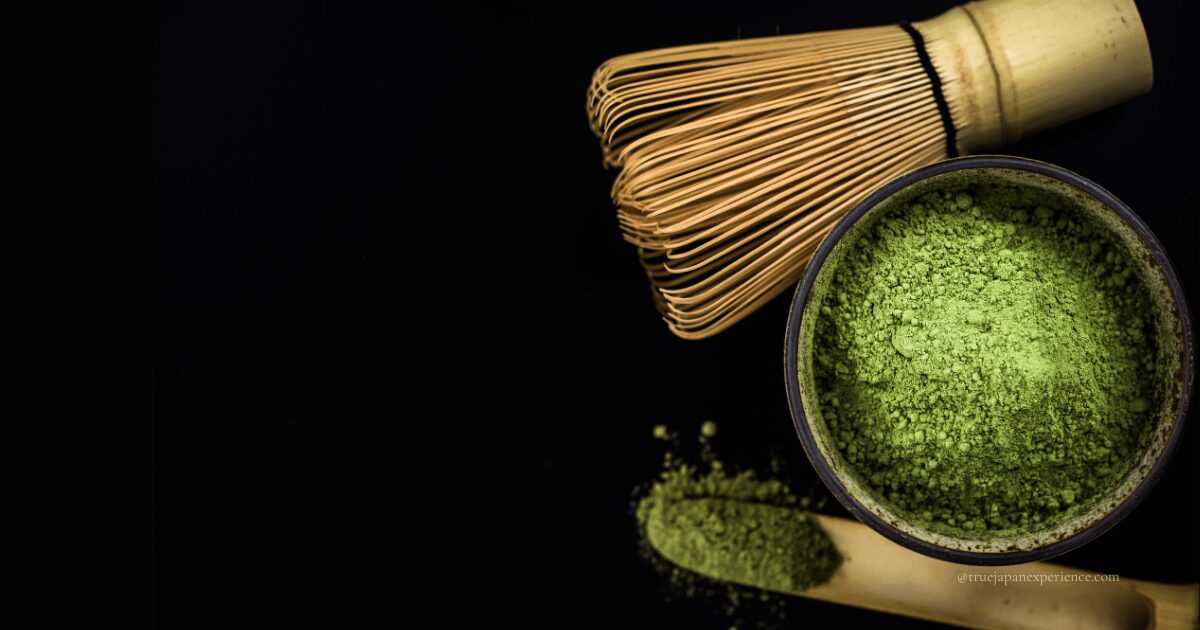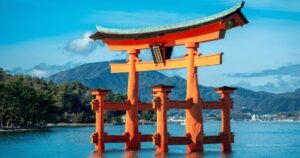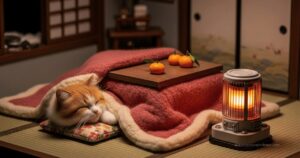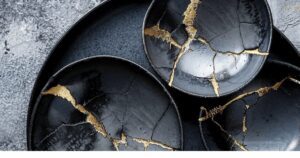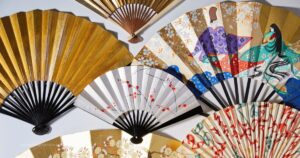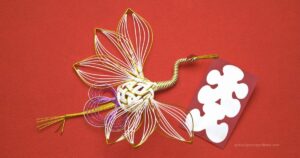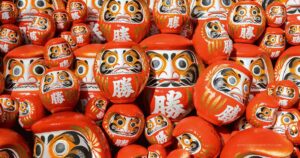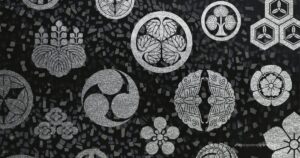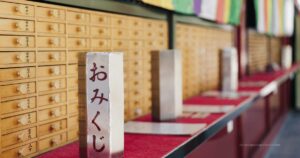The Japanese tea ceremony is more than just drinking tea. It is a deep cultural tradition that reflects the beauty, spirit, and hospitality of Japan.
If you want to truly understand Japanese culture, the tea ceremony is one of the best places to begin.
Let’s explore the meaning, etiquette, and experience of the Japanese tea ceremony—plus why Kyoto is the perfect place to try it.
We’ll also introduce places in Kyoto where you can join a tea ceremony, or simply enjoy a bowl of matcha while admiring a peaceful temple garden.
What Is the Japanese Tea Ceremony?
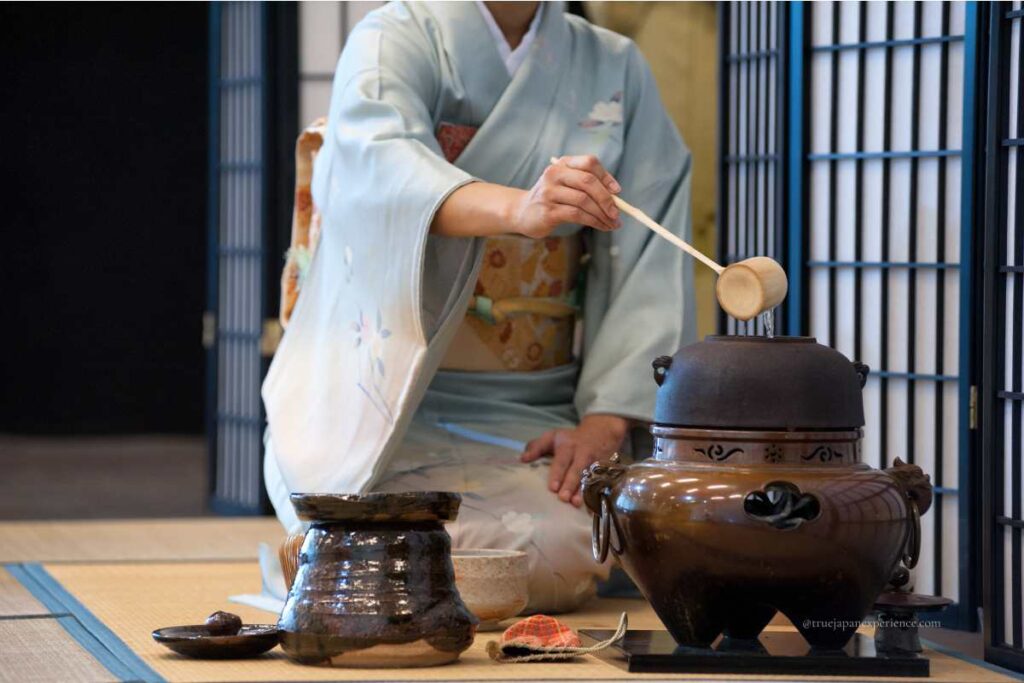
The Japanese tea ceremony, called sado (茶道) or chanoyu (茶の湯), is a traditional ritual of preparing and serving matcha, or powdered green tea.
But this ceremony is not only about the tea itself.
It expresses important values such as:
・Wa (harmony) – Respecting the mood and people around you
・Kei (respect) – Showing care to the host, guests, and tools
・Sei (purity) – Keeping the space, mind, and heart clean
・Jaku (tranquility) – Finding peace through the ceremony
The tea room is a quiet space, free from the rush of daily life. Here, the host and guest meet with full attention to the present moment.
This idea is also connected to wabi-sabi (the beauty of imperfection) and ichigo ichie (treasuring each unique meeting).
What Happens During a Tea Ceremony?
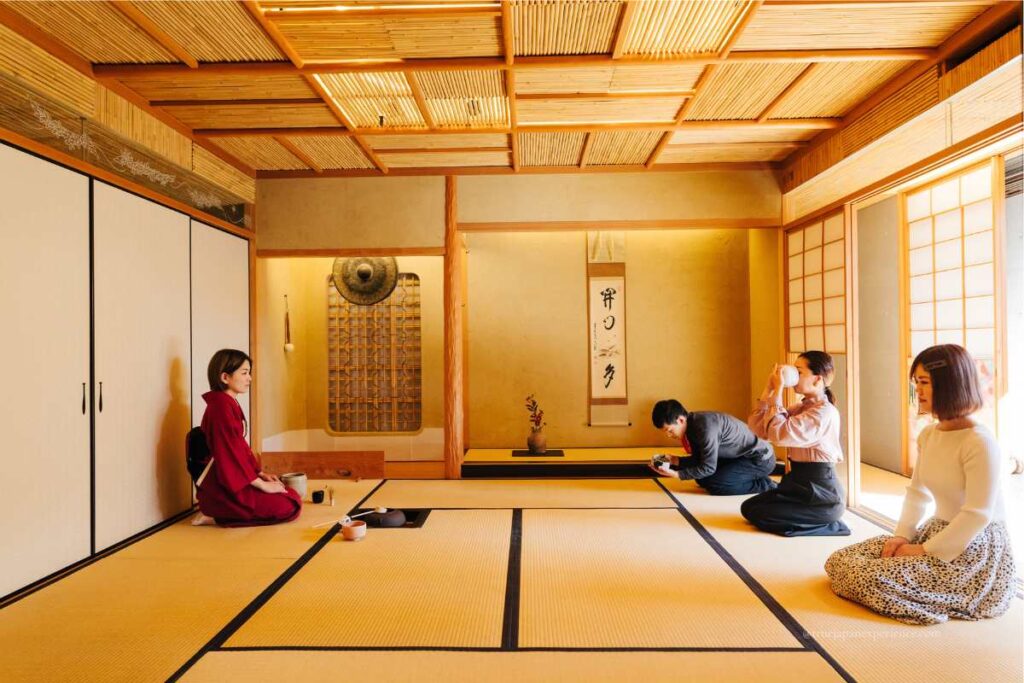
Many foreign visitors worry about doing something wrong during the ceremony. But don’t worry—it’s okay to make mistakes! The host is there to guide you kindly.
Before entering, you wash your hands and mouth with water. Then, you quietly go inside and sit in your place.
You bow to the host. Take a moment to look at the scroll, flowers, and tea tools.
Before the tea, a small sweet (wagashi) is served. Say “Excuse me” to the next guest, then eat it quietly. Use a paper napkin called kaishi.
When the tea comes, bow again and say “Otemae chodai itashimasu” to thank the host. Hold the bowl with both hands. Turn it twice to avoid drinking from the front. Then take a few sips.
After you finish, gently wipe the rim and put the bowl back.
At the end, bow once more and leave the tea room calmly.
Tea Ceremony Etiquette: Tips for First-Timers
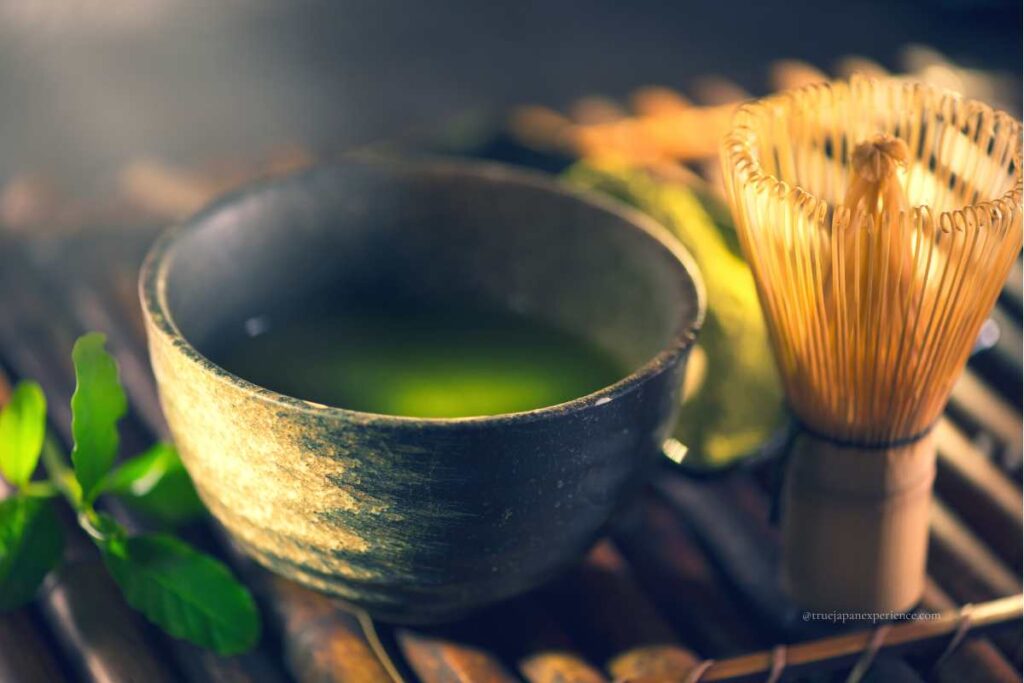
If this is your first experience, just remember these gentle tips:
・Take your time and move calmly.
・Handle the tea bowl and utensils with care.
・Show respect through simple gestures like bowing and silence.
・Most importantly, enjoy the peaceful atmosphere.
You don’t need to be perfect—just bring an open heart and appreciation for the moment.
Tools Used in the Tea Ceremony
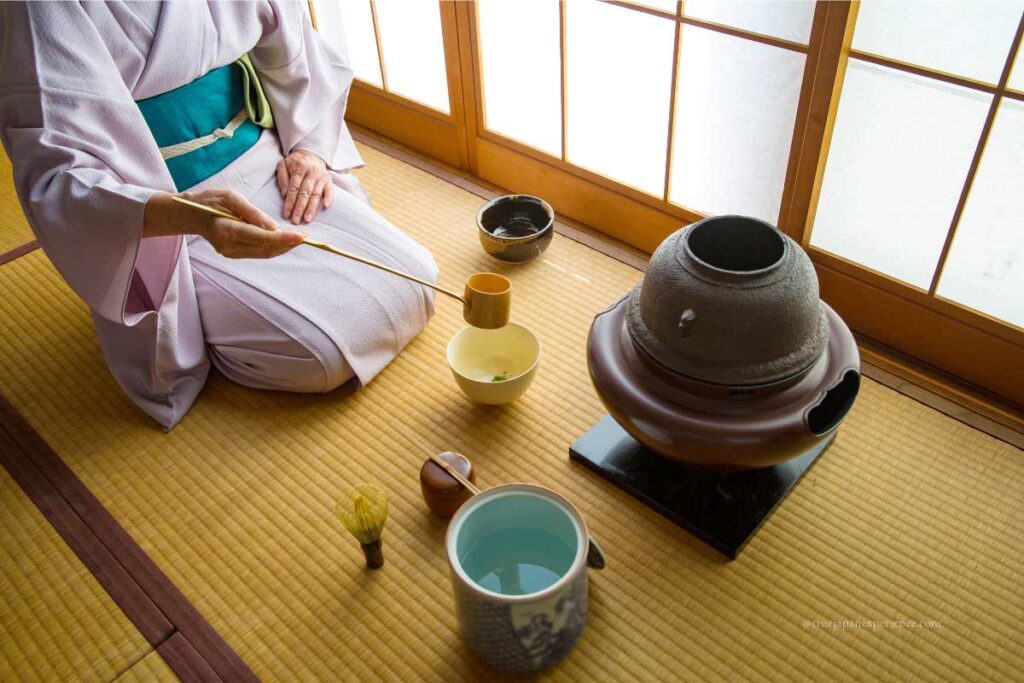
The tools used in the Japanese tea ceremony are beautiful and meaningful. Each has a purpose and history.
Here are a few key items:

These tools are part of the charm and depth of the tea ceremony.
Japanese Tea: Unsweetened and Unique
In many countries, tea is sweet. People often add sugar or honey. Bottled tea is usually flavored, too. This is common in Southeast Asia, the U.S., and Europe.
But Japan is different.
Here, tea is almost always unsweetened. Green tea, roasted tea (hojicha), and even matcha are served without sugar. You can find sugar-free tea in vending machines, stores, and restaurants across Japan.
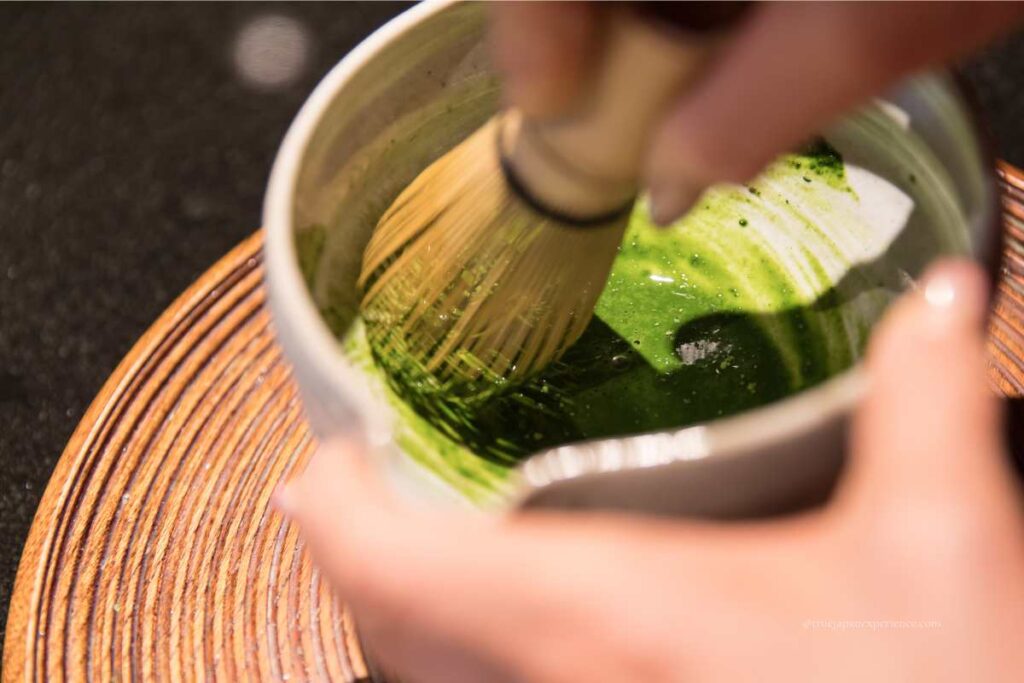
This may surprise you. Real matcha has a deep, slightly bitter taste. Many people call it an “adult flavor” because of its strong umami. That’s why sweets (wagashi) are served before tea—to balance the flavor.
At first, some visitors may find Japanese tea bitter or grassy. But as more people around the world care about health, many travelers enjoy this clean, natural taste.
If you’re from Japan like me, you might feel the opposite—sweet tea tastes strange!
Bonus: Wear a Kimono for the Tea Ceremony
Many guests choose to wear a kimono to feel more connected to Japanese culture. It also makes your experience (and photos!) extra special.
If you’re curious about kimono rental in Japan, be sure to read our related articles:
・Kimono Rental in Japan: How to Enjoy the Experience and Understand Its Meaning
・Best Places to Wear a Kimono in Japan: Traditional Streets, Scenic Spots & Hidden Gems
Why Kyoto Is the Best Place for a Tea Ceremony
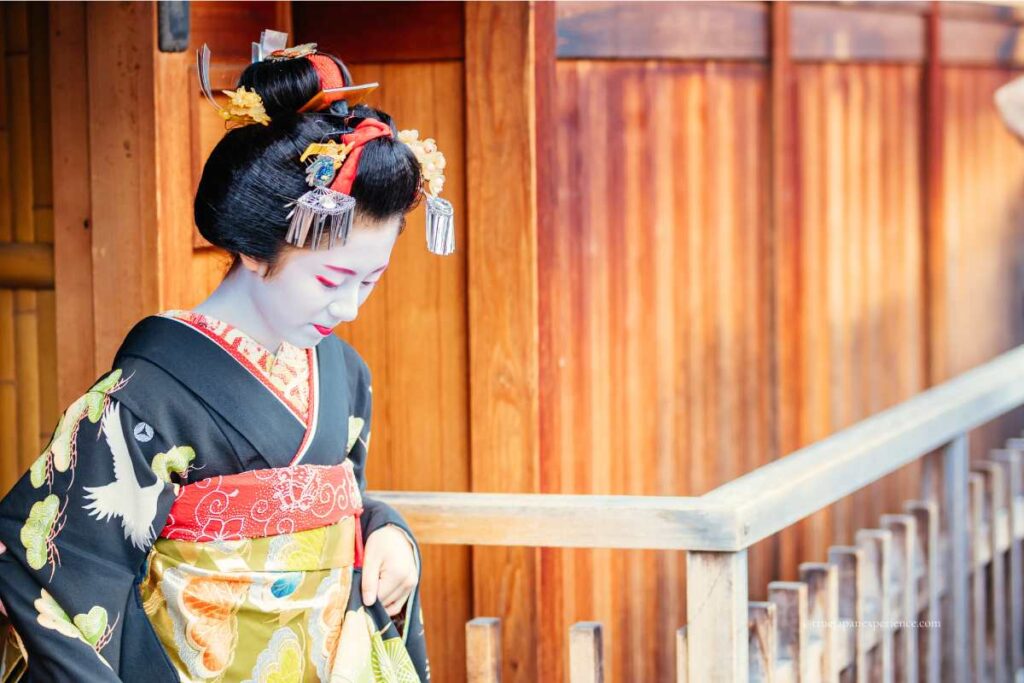
Tokyo offers many tea experiences. But if you want one that feels truly traditional and peaceful, we recommend trying it in Kyoto.
This old capital is where many tea traditions began. Its quiet temples, wooden townhouses, and seasonal beauty make the perfect setting.
In Kyoto, you can join a tea ceremony led by a skilled host. Some are held in real teahouses or temples. Many places also offer English support and short, easy sessions for beginners.
(We’ll introduce the best tea ceremony spots in Kyoto in the next section.)
Where to Experience a Tea Ceremony in Kyoto
Kyoto is one of the best places in Japan to experience an authentic Japanese tea ceremony.
From centuries-old tea shops to beautifully preserved townhouses, you’ll find a wide range of options—many with English support and beginner-friendly guidance.
Here are three top-rated tea ceremony experiences in Kyoto that combine tradition, hospitality, and unforgettable moments.
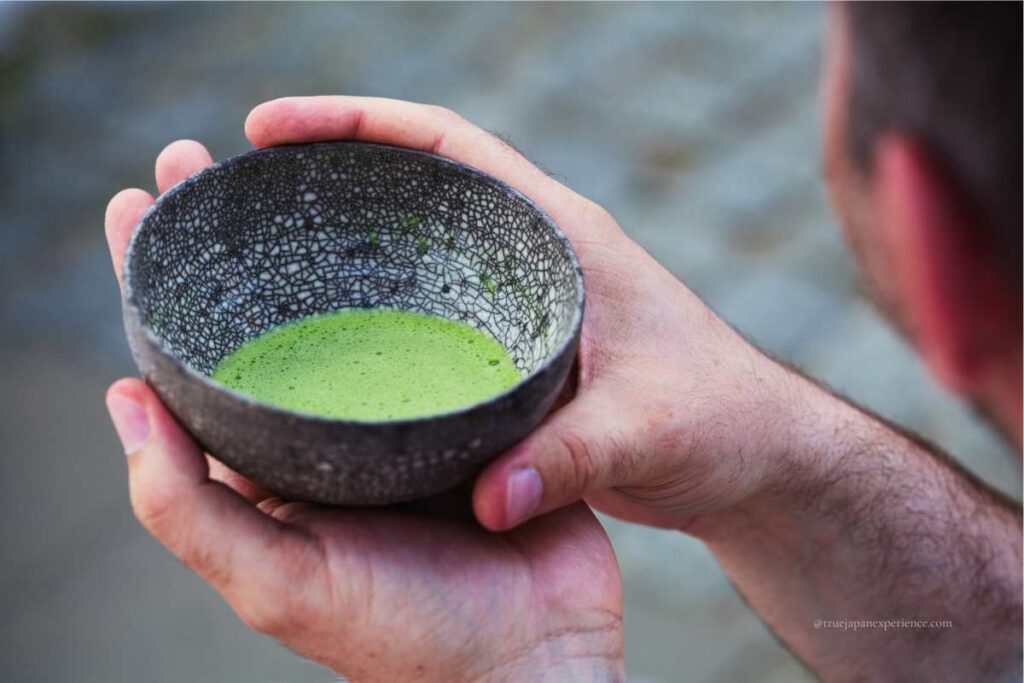
1. Bikouen – A Historical Tea Shop Near Kyoto Station
Founded in 1872, Bikouen has served as the official tea supplier (御茶司) for Nishi Honganji Temple for generations. The current owner is the fifth-generation tea master, and the hostess speaks fluent English and Chinese.
You can enjoy a calm and authentic tea ceremony in a traditional setting, just a short walk from Kyoto Station. It’s a perfect choice for travelers who want to explore the cultural roots of Japanese tea.
2. MAIKOYA – Multiple Historic Townhouse Locations
MAIKOYA offers tea ceremonies in beautifully preserved machiya (traditional townhouses), including:
・Karasuma Store – A Kyoto City–designated historic building
・Gion Kiyomizu Store – A nationally registered tangible cultural property
・Nishiki Store – Also a historic machiya with local charm
For five years in a row, MAIKOYA has been ranked No.1 on TripAdvisor for Kyoto tea ceremony experiences. They provide full English support, and no special dress or tools are required—just come as you are and enjoy.
3. Tea Ceremony Nagomi – Arashiyama and Ninenzaka Locations
Nagomi offers tea ceremony sessions in two iconic Kyoto areas: Arashiyama and Ninenzaka (near Kiyomizu-dera). English-speaking instructors guide you through the experience, with options for both shared and private sessions.
It’s a great choice for visitors exploring the scenic Arashiyama district or Kyoto’s famous temple routes.
Whether you’re near Kyoto Station, strolling through Gion, or walking among bamboo trees in Arashiyama, a tea ceremony is always within reach. Each location above offers a unique chance to connect with Japanese culture, history, and hospitality.
And if you want to make your experience even more special, don’t forget to wear a kimono!
Check out our guides here:
・Kimono Rental in Japan: How to Enjoy the Experience and Understand Its Meaning
・Best Places to Wear a Kimono in Japan: Traditional Streets, Scenic Spots & Hidden Gems
Not Ready for a Full Tea Ceremony? Try Matcha at a Temple
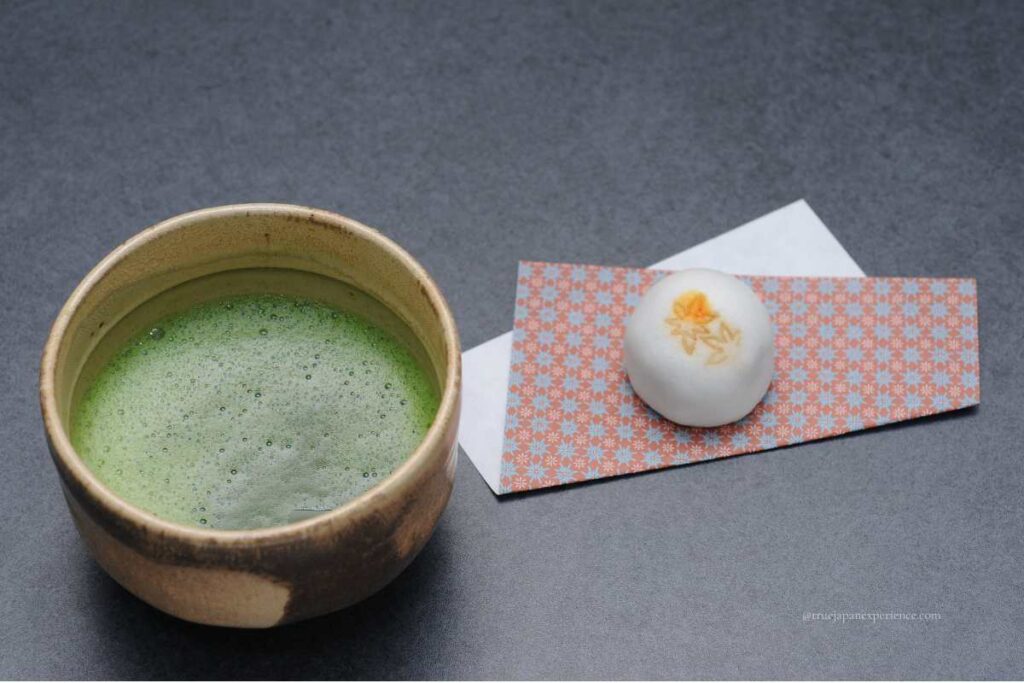
If a formal tea ceremony feels a bit too much, don’t worry. There’s a more relaxed way to enjoy matcha and feel the spirit of tea culture—by visiting a temple that serves tea in a peaceful garden setting.
In Kyoto, several Zen temples offer matcha and a sweet to visitors. You can sit down, enjoy the view, and take a quiet moment to reflect.
Why Do Temples Serve Matcha?
Matcha has strong roots in Zen Buddhism, especially in the Rinzai school. Long ago, monks drank matcha to stay awake and focused during meditation.
Making and drinking tea was more than just a habit. It was a spiritual practice that helped clear the mind and calm the heart.
This custom, called charei (茶礼), slowly became the base of the Japanese tea ceremony. Today, temples continue this tradition. Serving matcha helps visitors slow down and enjoy the moment.
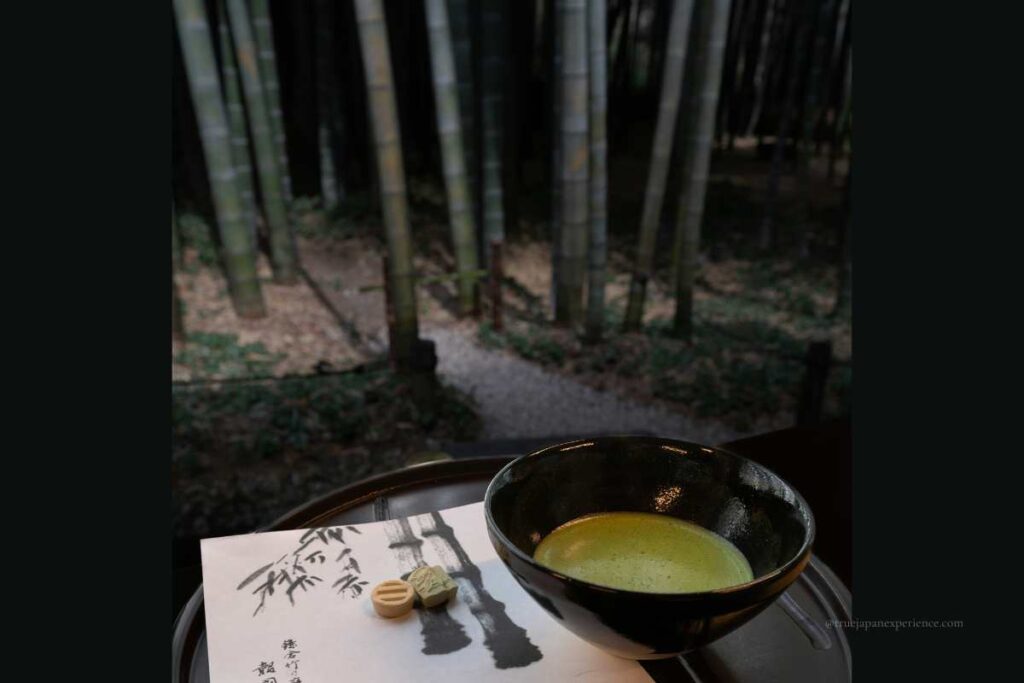
Temples in Kyoto Where You Can Enjoy Matcha
Here are three temples where you can experience this peaceful tradition:
◆ Sanzen-in (Ohara area) –
Enjoy matcha and sweets on the wooden veranda overlooking the historic Shuheki-en garden. The quiet and natural beauty of this temple creates a perfect moment of peace.
Google Maps: View location
◆ Nanzen-ji Hojo Garden –
This famous Zen temple features a dry landscape garden. You can sip matcha while viewing the elegant simplicity of its stones and sand. It’s a popular spot for both garden lovers and spiritual seekers.
Google Maps: View location
◆ Unryu-in (Sennyu-ji Temple complex) –
A lesser-known gem with imperial connections. You can enjoy matcha while sitting in a chair, gazing through the round window known as “Window of Enlightenment.” The quiet atmosphere is perfect for reflection.
Google Maps: View location
Even without joining a full tea ceremony, this is a wonderful way to taste real matcha and feel the Zen spirit behind it.
It’s not just a drink—it’s a gentle invitation to slow down, breathe, and appreciate the present.
